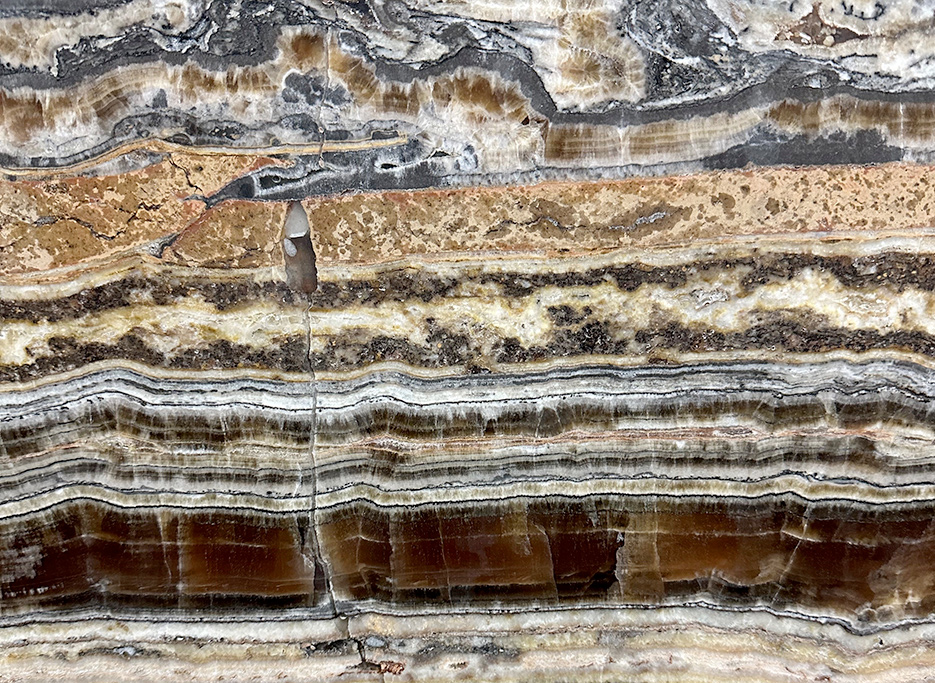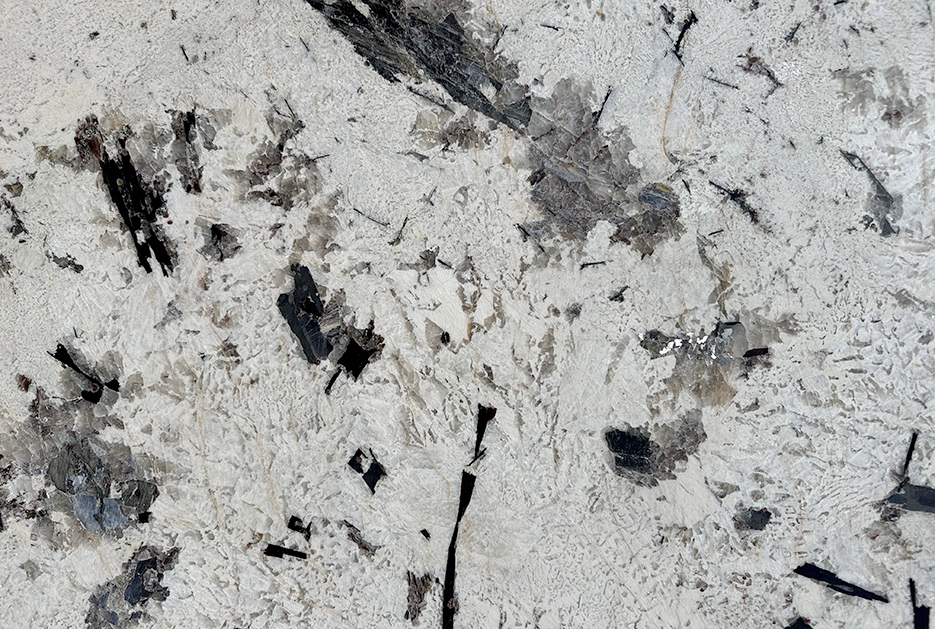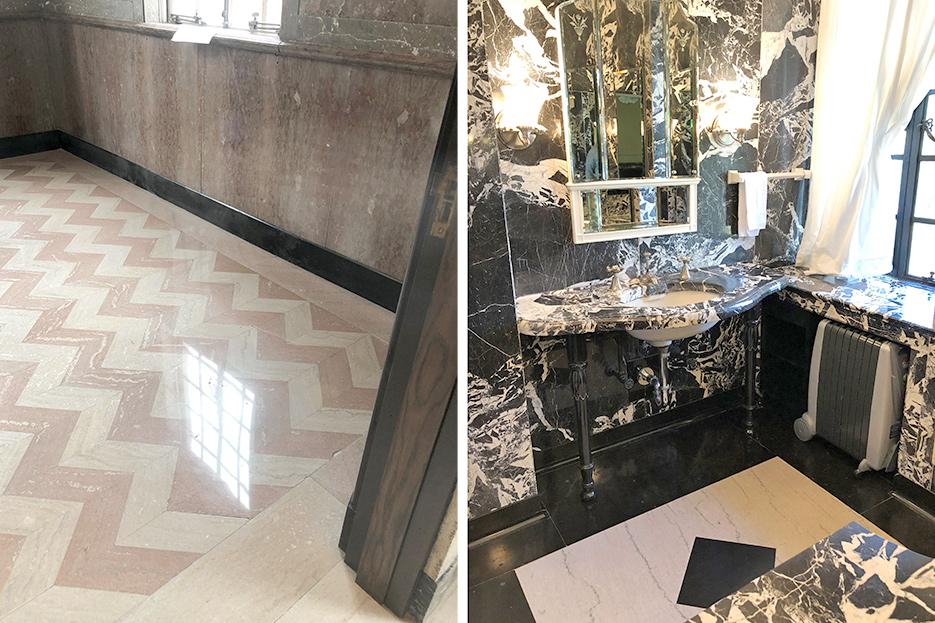Stone Restoration and Maintenance Corner – Handling New and Difficult to Polish Stones
Bob Murrell
M3 Technologies
Photos by Bob Murrell
As a stone restoration and maintenance contractor, you run across many types of stones, especially in 2024. There are new stones that are being used as building materials, more so than ever before. More and more exotic stones are also being used, and in many cases have their own set of issues. Used to be, polishing rock was pretty straight forward; there were a few different types of marble, granite, travertine, limestone, and slate. Of course, there were also the sandstones and flagstones, terrazzo, and few others, but this was the norm.
Nowadays, it is not uncommon to run into onyx, alabaster, jade, more and more epoxy terrazzo, and of course, the dreaded quartzite. There are so many exotic marbles and granites that I’ve only seen in the last few years, and I’ve been doing this for about 50 years now. There are those who want the most ornate stone they can find, just because it’s not common and no one else on their street has it.
Now, with all these exotic stones in brilliant colors in the marketplace, they obviously have different mineral content, even though they may be classified as marble or limestone or granite. The different minerals are what make all the pretty colors and veins. Of course, most are still calcium-based or quartz-based.
 |
|
Above: Polishing a very ornate onyx poses challenges as it contains fairly soft material. Below:: Silver Tapestry granite (actually a type of gneiss, I believe) with large inclusions of quartz. |
 |
|
Below: Leathered, resin/color enhanced Negresso needs careful handling. |
 |
Geologically speaking, there are only a few true marbles and the same is true for granite, as well. However, for our purposes, and commercially speaking, we group most of the metamorphic limestones as marble and the metamorphic granites as, you guessed it, granites. These later stones are actually gneiss. Gneisses are usually the granites with lots of movement, which some mistake for veining.
For example, black granites are not true granites at all. They are basalt, anorthosite, or gabbro. Commercially, we call them black granites. Pink Tennessee marble is not a true marble, it is a metamorphic limestone, and the same is true for many stones that we label marble. Carrera marble is an example of a true marble.
Onyx is another example of a calcareous stone, like marble and limestone. So is Alabaster. These stones can be somewhat finicky to polish as they tend to be soft. I have polished a particular (under-lit) onyx bar top for many years now, when the client wants it to look fresh again. I get a call from them about every 2-3 years, as they do tend to take good care of it. I usually go down to about a 220 grit then proceed to a 400, and then an 800 grit before polishing using Majestic 5X Gold. It works every time, but extra care must be taken as scratching and even heat swirls from the 5X are a constant battle. On some onyx and marble, I prefer the performance of the Majestic DiaBrite 10X or the Majestic XXX polishing powders. It pays to have them on the truck. If you’re not getting the results you expect, and you have tried varying the amount of water to powder ratio, the number of passes or time per square foot, and/or weight of the machine, try the 10X or XXX.
 |
|
Above: Old school exotic marble, including Tennessee Pink wall cladding – a true craftsman install done in the in the 1930s-1940s.
Below, Left: A very ornate-looking Splendor White, another type of “granite” material, with shiny but fragile mica inclusions scattered throughout. Below, right:: Black and white Italian marble. Pretty exotic though, wouldn’t you say? |
 |
We have so many brands of engineered stones now that I can’t keep up with them anymore. Quartz or engineered stone is basically a material that has similar characteristics to granite. They are made of quartz and resin. We have special polishing kits for the quartz materials called Quartz Renew. It contains special polishing pads which are used with specific compounds that are designed to give excellent results when refinishing these harder materials.
There are also manufactured or engineered marbles as well. I have used the standard polishing procedures for the engineered marbles with good success. You may have to play around and experiment with the different polishing powders (like 10X or XXX), but you should be successful.
Not only are there many more exotic stones in the marketplace now but there are also some new surface finishes, too. Have you ever heard of 3D soapstone? It is a bizarre material which is heavily textured but finished like the leathered or antiqued materials to achieve some tightness at the surface. These textured materials should be sealed for sure. There would be little to no refinishing that could take place due to the dimensional features, other than using brushes and chemicals.
There are also more and more honed materials gaining popularity today. This is “no brainer” as these materials, especially calcareous in nature, will show less etching and scratching. They also have what I have always called the “European” look. These normally require refinishing with normal diamond abrasives, only less high in the grit series. I call a good, honed look around a 200 grit, maybe less or more, depending on the particular stone.
My point is this, there are so many stones being used in the dimensional building stone industry nowadays, you will be getting requests to restore them, at some point. You will need to be ready for working on them, so have all of your tools in order. Most tooling will be universal, with the textured materials being an obvious standout regarding the use of different tooling. Test, test, test! Call me or another experienced reference, when in doubt. We should be able to give you some pointers.
I always recommend doing a test area on any project to confirm both the results and procedure. Also, the best way to help ensure success is by partnering with a good distributor, like BB Industries, that knows the business. They can help with technical support, product purchase decisions, logistics, and other pertinent project information.
Bob Murrell has worked in the natural stone industry for over 40 years and is well known for his expertise in natural stone, tile, and decorative concrete restoration and maintenance. He helped develop some of the main products and processes which revolutionized the industry, and is currently the Director of Operations for M3 Technologies.
Send your comments and questions to Bob at attn: publisher@slipperyrockgazette.net .